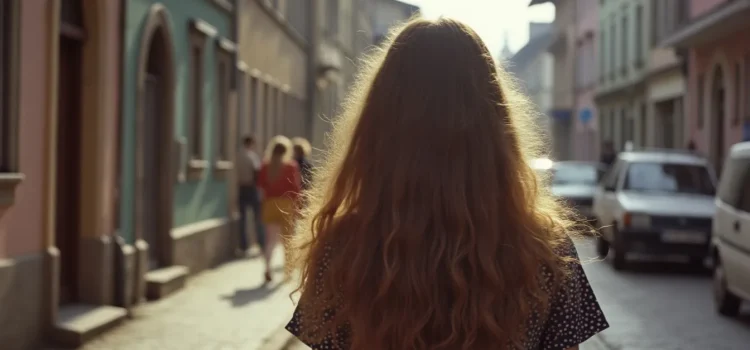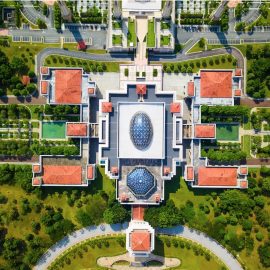

This article is an excerpt from the Shortform book guide to "Melania" by Melania Trump. Shortform has the world's best summaries and analyses of books you should be reading.
Like this article? Sign up for a free trial here.
What shaped Melania Trump’s early years in Slovenia before her rise to international fame? How did a chance encounter with a photographer transform her life’s trajectory?
Melania Trump’s background reveals a journey from a small Slovenian town to the global stage. Her story weaves through the cultural landscape of 1970s Yugoslavia, where her parents’ influence and the region’s unique political climate helped shape her character and ambitions.
Continue reading to explore the fascinating path that led a young Melanija Knavs to become one of the most recognized women in the world.
Melania Trump’s Background
Melania Trump’s background is discussed in her memoir Melania. She was born Melanija Knavs on April 26, 1970, in Novo Mesto, Slovenia. Her father Viktor advanced from being a Yugoslavian Army driver to managing car dealerships, while her mother Amalija worked as an artist and patternmaker, which influenced Melania’s lifelong appreciation for fashion—a passion she shared with her older sister, Ines.
(Shortform note: Melania Knavs adopted the Germanized name Melania Knauss when she began her modeling career, later taking the name Trump when she got married. Her parents, Viktor and Amalija Knavs, kept their original Slovenian surname. Victor and Amalija Knavs became US citizens in 2018 through family-based immigration (known as “chain migration”)—a process their son-in-law Donald Trump sought to eliminate during his presidency. Until Amalija’s passing in January 2024 at age 78, the couple split their time between residences in Trump Tower in New York, Mar-a-Lago in Florida, and their house in Slovenia, with Viktor now continuing to live in the United States.)
Melania disputes portrayals of her childhood as bleak or deprived, describing it instead as happy and enriching. Despite growing up in Slovenia during a time marked by the remnants of communism and the Cold War, she says her childhood in the scenic town of Sevnica provided her with a stable environment and the opportunity to explore creativity and culture. Her family traveled to the Dalmatian coast of Croatia and other European countries, broadening her worldview. According to Melania, these early experiences, combined with her parents’ emphasis on hard work and dedication, laid the foundation for the values that would shape her life—creativity, commitment to family, and financial independence.
| Historical Context: Slovenia During Melania’s childhood in the 1970s and 1980s, Slovenia was part of the Socialist Federal Republic of Yugoslavia, led by Josip Broz Tito. After World War II, Slovenia became Yugoslavia’s most prosperous region due to a distinct economic system called “socialist self-management,” introduced after a split from Soviet influence in 1948. Unlike many other communist countries, this system allowed for some level of economic independence and cultural openness, making Slovenia relatively affluent and progressive. The period saw attempts to liberalize further, with movements pushing for more local autonomy and democratic freedoms. Despite existing tensions with the central Yugoslav government, these developments laid the groundwork for Slovenia’s eventual peaceful move toward independence in the early 1990s. |
Melania’s Modeling Career
As a child, Melania began her journey in fashion by modeling her mother’s creations on Belgrade runways. During her teenage years, she enrolled at the Secondary School for Design and Photography in Ljubljana, pursuing industrial design to combine her passions for art, graphics, and fashion. She later became interested in architecture.
Her professional modeling career took off unexpectedly in 1987 when photographer Stane Jerko discovered her. By 1992, the 22-year-old was juggling architecture studies with modeling work. Following her sister Ines’s suggestion, she participated in the “Look of the Year” competition in Portoroz, securing second place and a contract with RVR agency in Milan. This success led her to choose modeling over architecture.
Though she moved to Milan, Melania felt limited by RVR’s opportunities. She sought out Riccardo Gay, who ran one of the industry’s most prestigious agencies. Under Gay’s management, her career expanded significantly, enabling her to work with luxury brands worldwide. After spending two years in Milan, she relocated to Paris, where Paolo Zampolli of Metropolitan Models offered her work in New York City.
While Melania enjoyed the glamour and financial freedom of modeling, she faced numerous challenges, including constant rejection and criticism. She observed colleagues struggling with substance abuse and alcohol, but took pride in maintaining her professional integrity and staying focused on her goals. She emphasized the importance of keeping a professional demeanor and optimistic outlook while resisting industry pressures.

———End of Preview———
Like what you just read? Read the rest of the world's best book summary and analysis of Melania Trump's "Melania" at Shortform.
Here's what you'll find in our full Melania summary:
- Melania Trump’s journey from Slovenia to the White House
- The challenges Melania faced as First Lady of the United States
- Never-before-heard anecdotes from Melania






